IDEX Online Research: U.S. Jewelers’ First Quarter Sales Weak
July 10, 07
Most U.S. specialty jewelers reported that their sales were weaker than expected in the first quarter of 2007 (most jewelers operate on a fiscal quarter ended April). While some jewelers reported strong results – notably higher-end merchants such as Tiffany and Harry Winston – most jewelers said it was more difficult to generate sales in the first fiscal quarter.
Sales were affected by three key factors:
- Store traffic declined – Most jewelers said that their store traffic was down in the first quarter versus the same period last year. Valentine’s sales were not particularly strong.
- Fewer sales transactions – Even high-end jewelers reported that their sales associates wrote fewer sales tickets. Most jewelers claimed that the conversion rate (browsers-to-buyers) held about steady, year-to-year.
- Higher average ticket – Almost every jeweler noted that the only good news was that the average ticket rose. Two factors helped to generate a higher average ticket:
- Greater sales of better quality, larger diamonds.
- Gold jewelry which now carries a higher average ticket because of the rising price of gold.
In addition, jewelers who are on a fiscal first quarter (February, March, and April) reported that an early Mother’s Day selling period helped boost first quarter sales, but noted that it will negatively affect sales comparisons in the second fiscal quarter (ending July).
The U.S. Department of Commerce reported that specialty jewelers’ sales rose by a very modest 0.5 percent in the first fiscal quarter (February, March, April) of 2007 versus the same three-month period in 2006, as the graph below illustrates.
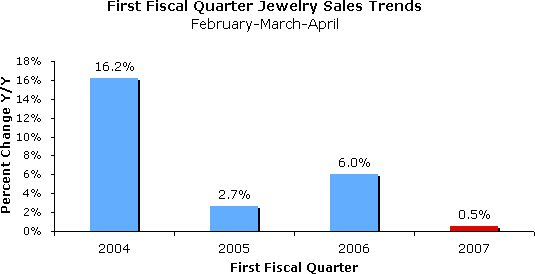
Source: U.S. Dept. of Commerce
The U.S. Department of Commerce also reported that specialty jewelers’ sales rose by a modest 1.4 percent in the first calendar quarter (January, February, March) of 2007 versus the same three-month period in 2006, as the graph below illustrates.
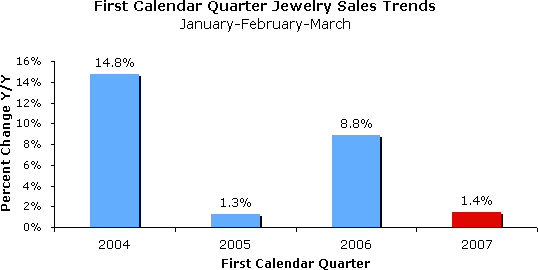
Source: U.S. Dept. of Commerce
The graph also illustrates just how volatile first quarter sales comparisons can be: in 2004 and 2006, the first quarter sales periods were very strong; in 2005 and 2007, the first quarter sales periods were very weak.
First Quarter Sales Trends Set the Pace for the Year
For the past three years, jewelers’ sales trends in the first quarter have set the tone for sales for the full year. We believe that first quarter results can be a reliable harbinger for full year results, as the graph below illustrates.
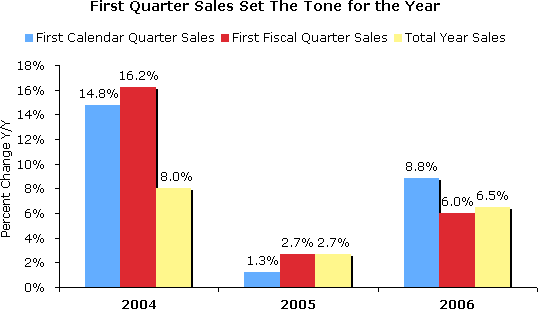
Source: U.S. Dept. of Commerce
For most specialty jewelers, the first quarter is not particularly important. For those jewelers who report results on a calendar quarter, first quarter sales are about 20 percent of total year sales, as the graph below illustrates.
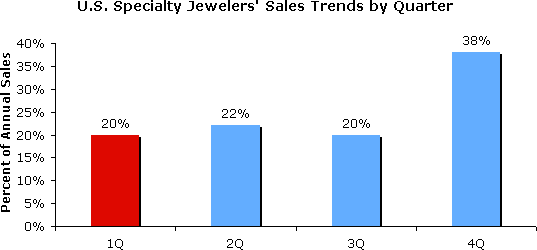
Source: U.S. Dept. of Commerce
For jewelers on a fiscal first quarter – February, March, April – the first quarter represents about 21 percent of total annual sales. This slight sales mix shift between the calendar quarter and the fiscal quarter is because January is a much less important month than April.
PUBLIC COMPANIES’ RESULTS
The good news is that most publicly owned jewelers gained market share in the first quarter. The bad new is that if you are an independent jeweler, you most likely lost market share to the publicly owned jewelers such as Kay, Tiffany, and others.
The graph below summarizes who gained market share (almost all of the public jewelers) and who lost market share (only Zale).
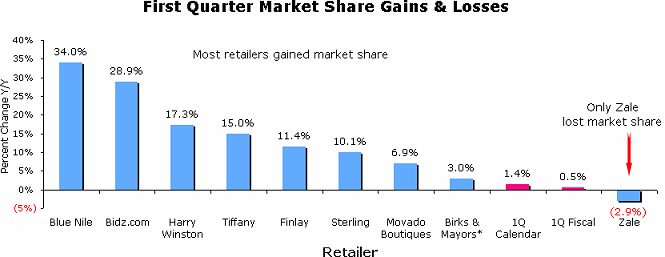
Source: U.S. Dept. of Commerce & company reports
GUILD JEWELERS
Guild jewelers reported much stronger sales than mass market fashion jewelers. The higher end customer is less affected by economic factors.
Tiffany & Co. – U.S. total retail sales for Tiffany stores rose by a robust 15 percent to $299 million; same-store sales in the U.S. were up by 12 percent in the first quarter ended April 2007. U.S. retail sales were 48 percent of Tiffany’s total corporate revenues in the first quarter. The following factors had an impact on sales.
- The average ticket rose.
- The number of transactions was up modestly.
- Sales in the company’s New York Flagship Fifth Avenue store rose by 26 percent in the quarter, driven largely by tourists from overseas markets buying Tiffany merchandise. The weak U.S. dollar was partially responsible for strong tourist spending. In addition, major renovations were completed last year in this store which helped boost sales. New York branch store sales rose by 8 percent.
- Sales in all U.S. branch stores (64 units) rose by 9 percent.
- Sales were particularly strong in Tiffany’s Florida stores, Atlanta, Houston and the California stores. Sales were soft only in two markets: Hawaii and Guam.
- Demand showed double-digit gains in almost all price categories, but was particularly robust for jewelry priced $50,000 and above.
- Despite strong spending by overseas tourists in the company’s New York Flagship unit, domestic customers accounted for more than half of the U.S. retail sales gain.
- Direct marketing sales were up by 11 percent to about $33 million. Both the average ticket and the total number of orders were higher in the quarter. Direct marketing sales were 5 percent of corporate revenues in the quarter. About 80 percent of the company’s direct sales are a result of online commerce; we estimate that Tiffany’s online sales were at least $26 million in the first quarter.
- Sales in Tiffany’s “other” category include wholesale sales of diamonds, revenues from Little Switzerland and revenues from Iridesse. This category accounted for $41 million of total revenues, or just under 7 percent of total corporate sales. Wholesale diamond sales rose 62 percent to $13.6 million. Little Switzerland sales rose by 5 percent. Management did not give out any numbers for Iridesse, but says it remains “encouraged” by this division’s performance.
Harry Winston – Harry Winston posted a strong 17 percent sales gain in the first quarter ended April 2007. Total sales were $58.6 million, up from last year’s $50.0 million. The following factors had an impact on the company’s sales.
- Sales in the six U.S. stores were $24.3 million in the quarter, up 15 percent from the prior year.
- Sales per store in the U.S. market were just under $4.1 million each in the quarter.
- Sales in the company’s European stores were up nearly 36 percent.
- Sales in its Asian stores – mostly Japan – were down almost 4 percent in the quarter, as the graph below illustrates.
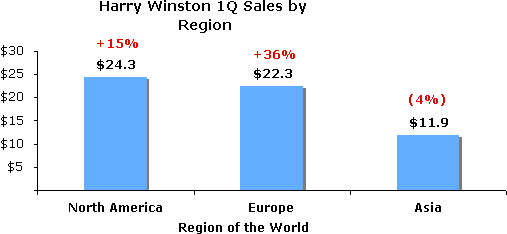 Source: Company reports |
- The company had 14 stores in operation at the end of the first quarter, up from 11 units in the first quarter of 2006. The three new stores – Tokyo, Dallas and London – helped drive sales in the first quarter. Aber’s retail segment includes sales from Harry Winston’s 14 salons, which are located in New York, Honolulu, Bal Harbour, Beverly Hills, Las Vegas, Dallas, Paris, London, Geneva, Tokyo (Ginza, Omotesando and Roppongi), Osaka and Taipei.
- Changes in the company’s sales mix helped boost sales. While management was not specific, we believe that sales of bigger ticket items grew more rapidly than sales of lower ticket goods.
- Strong demand for high-end luxury goods helped boost sales for Harry Winston.
- Management’s long term goal is to increase Harry Winston sales by 15-20 percent annually.
- In the first quarter, about 41 percent of Aber Diamond’s revenues were generated by Harry Winston.
- Aber Diamond is changing its corporate name to Harry Winston later this year.
Birks & Mayors – Total sales for the three months ended March 2007 were down 1.7 percent; same-store sales rose by 3 percent. The following factors had an impact on the company’s sales in the first period of the calendar year (Birks & Mayors’ fourth fiscal period).
- In the prior year, Birks & Mayors had some one-time corporate sales and factory sales to third parties that did not occur in this year’s March period. While the company did not quantify the level of these sales, we believe that total revenues, without last year’s one-time sales, were higher this year than last year.
- Same-store sales were up 3 percent in both the U.S. and the Canadian stores.
- While same-store sales were the same level in both major markets, underlying demand trends were different. Demand in Canada remains solid. In Florida, demand is inconsistent, with some stores up and others down. Further, demand apparently is not following normal seasonal trends.
- Foreign currency translation hurt March quarter revenues by about $300,000. For the fiscal year ended March 2007, foreign currency translation boosted sales by about $5.3 million.
- Sales were boosted by a sale during January in the Mayor’s stores; last year, this annual sale was held in April. Again, the company did not quantify the magnitude of the revenues from this sale.
- Marketing efforts were similar in the March quarter of 2007 versus the same period last year.
- The company operated 67 stores in both years: 38 Birks units in Canada and 29 Mayors in Florida and Georgia (U.S.). However, there were some significant store remodels, and one downsizing. One store closed, and another was opened during the year.
- The company added two Van Cleef boutiques in its Canadian division last year. It also added more Birks branded goods to its Mayors division.
- Corporate sales per square foot were $946 this year (ended March 2007), up 8.6 percent from last year’s $871.
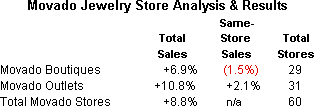 Source: Company reports |
- Movado closed two of its under-performing Boutique units in the quarter (SoHo New York and Northbrook IL, a suburb of Chicago).
- Same-store sales were hurt by the maturing of a large number of the Movado Boutique stores. Store growth in this division has been slower than anticipated, and it appears that many of the stores are near their peak sales level, based on the current merchandise mix.
- Management admitted that it had unwittingly vacated some key retail price points. It plans to go back and fill in with product to cover those important price points.
- Management said that it needed to increase both sales per store and sales per square foot in the Movado Boutiques. Sales per store in the first quarter of this year were about $303,600, down 0.3 percent from last year. For the full year ended January 2007, Movado’s sales per store were down more than 5 percent to about $1.470 million each.
- Movado’s Boutique stores average 2,200 square feet in size, and its Outlet stores average 1,690 square feet. Both of these are larger than most mass market chain jewelers, but are smaller than the typical guild store. On average, Movado’s stores produced sales of $754 per square foot last year; this is at the low end of the range for a specialty jeweler. Gordon’s and Zale both produce sales at around $800 per square foot; Kay and Mayor’s sales are in the range of $1,100 per square foot; and, Tiffany U.S. branch sales per square foot are about $2,300. At typical AGS store produces sales around $1,000 per square foot. We believe that Movado’s average ticket (Boutique units) is in the $850-900 range, in line with an AGS store.
MASS MARKET FASHION JEWELERS
Jewelers targeting middle market consumers have felt the pressure from higher gasoline prices, rising interest rates, and other pressures that are taking a toll on middle-income consumers’ discretionary spending.
Finlay Enterprises – For its first fiscal quarter ended April 2007, Finlay Enterprises reported a very strong 11.4 percent sales gain and a solid 8.1 percent same-store sales increase. The following factors had an impact on the company’s revenues.
- Management estimates that underlying same-store sales rose by 4-5 percent. The incremental 3-4 percent was due to a shift in sales related to an earlier Mother’s Day selling period this year. While Mother’s Day is in the second fiscal quarter, a significant portion of Mother’s Day jewelry demand occurs in late April, a period that falls within Finlay’s first fiscal quarter ending at the end of April.
- The specialty stores division contributed $27.2 million in sales, or about 16 percent of corporate revenues in the quarter. Finlay’s specialty stores consist of the Carlyle (33 units) and Congress (5 stores) chains.
- Sales in the Congress specialty stores were weak; this is related to the lack of vibrancy in the economy of South Florida, according to management.
- Carlyle’s sales are running above plan; its stores are scattered across the Southeast.
- Finlay’s best performing leased departments were in Bloomingdale’s, Macy’s South, and Macy’s Northwest.
- Management said that the average ticket was up due to trading up by Finlay’s customers.
Sterling Jewelers – For the fiscal quarter ended April 2007, Signet’s U.S. division, Sterling Jewelers, reported that sales were $632 million, up 10.1 percent. Total corporate sales, including the U.K. division, were $814 million, up 10.9 percent for the quarter. The following factors had an impact on the company’s first quarter revenues in its U.S. stores.
- Sterling’s reported same-store sales were up 3.2 percent. However, the “underlying” growth of same-store sales was about 1.9 percent. Adverse weather during the Valentine’s selling period hurt demand, but the timing of a Mother’s Day promotion (since it was earlier this year) had a significant benefit. Removing these two unusual events, management said that same-store sales would have been up by about 1.9 percent. Management also noted that the “tone” of sales had softened in the quarter.
- The average transaction was up by about 5 percent, both in the mall stores and in Jared. Last year, the average ticket in a Sterling mall store (Kay and regional brands combined) was $317; the average ticket in a Jared store was $719 in 2006. Two factors helped drive the average ticket higher.
- Price adjustments (read: higher prices) helped boost the average ticket.
- Demand for better quality, more expensive diamonds helped sales and the average ticket.
-
- Management cited several factors that may be contributing to softer demand for discretionary merchandise such as jewelry.
- Higher gasoline prices.
- Higher interest rates.
- Re-setting of variable mortgage interest rates at a higher level for those consumers who refinanced their home a few years ago.
- Housing price uncertainty.
-
- Management said there was no significant difference in sales trends between its mall stores and the Jared free-standing stores.
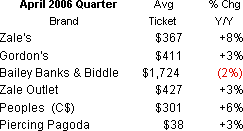 |
- Virtually all of the operating divisions posted negative same-store sales comparisons, except for the Zale Outlet which experienced flat same-store sales.
- We were surprised that Zale did not cite an early Mother’s Day as having a positive impact on sales in the quarter ending April. Adjusting for the timing of this year’s Mother’s Day, Zale’s year-over-year sales comparisons in the April quarter would have been worse.
- Most of the operating divisions generated a higher average ticket, but saw fewer sales transactions. The average ticket rose 3.9 percent (year-over-year) to $185. The average ticket by division was as follows:
- The company added $59-199 retail price jewelry, including diamond jewelry, to try to boost sales to upper end customers at its Piercing Pagoda kiosks.
- There were fewer transactions under $500 in the quarter.
- Stores in power centers were the strongest group; new store sales are running above plan.
- The company’s new lifetime protection program helped boost business. While the revenues don’t flow through sales (those sales are amortized over five years), these sales helped generate significant cash. Management says that reported revenues in the quarter were lower by $8.7 million, or 1.7 percent, due to amortization of the lifetime protection program over five years rather than the prior two-year period.
- Zale’s online commerce was up 50 percent; traffic was up 20 percent, and the conversion (browser-to-buyer) rose by 30 percent in the quarter. For the company’s full fiscal year ended July 2006, online jewelry sales were an estimated $25 million for Zale. In the first fiscal quarter (October 2006), online jewelry sales were $4.8 million for Zale; management did not quantify online commerce financials for the most recent quarter.
- During the quarter, the company opened 11 stores and one kiosk. It closed 13 stores and 60 kiosks.
ONLINE JEWELRY MERCHANTS
Online jewelry sales continue to grow rapidly. While there is some evidence that online sales growth in other retail categories may be slowing, online jewelry sales continue to expand rapidly. Our forecast calls for slowing growth, with online jewelry sales reaching 6-8 percent of total industry growth by 2010. We continue to believe that most jewelry sales (90 percent or more) will take place in a store-based environment. We do, however, believe that the financial model that online merchants have created could help boost the financial strength of store-based jewelry retailers, if those store-based retailers were to embrace even some aspects of that highly successful financial operating model.
Blue Nile – Blue Nile’s sales rose to $67.9 million, up 34 percent from the prior year’s $50.7 million. The following factors had an impact on this online jeweler’s revenues.
- Blue Nile’s average ticket rose 3.6 percent to $1,536 in the quarter.
- Total orders were up 29 percent in the first three-month period of the year.
- Sales were driven by both more traffic and a higher conversion rate (browser-to-buyer).
- Repeat and referral revenues grew faster than sales to new customers.
- Improvements to the company’s website also boosted sales.
- Sometime in late March, the company crossed the threshold of $1 billion in sales since Blue Nile was founded in 1999.
- Blue Nile’s international sales – currently Canada and the U.K. – were $2.6 million, up over 80 percent from last year’s $1.4 billion in the quarter. International sales were just under 4 percent of total corporate revenues.
Odimo – Is Odimo down and out? Its first quarter (period ended March 2007) legal filing with the Securities & Exchange Commission says, “(...) the company is a non-operating public shell company.” Here’s how its financials stack up.
- Odimo had no sales in the first quarter. It earned $13,000 in commissions relating to sales from ashford.com which were handled by ice.com.
- It had about $100,000 in cash and just over $300,000 in total assets. Its current liabilities were almost $900,000, and it had another $500,000 in long term liabilities. Technically, it is bankrupt, though it is not insolvent (due to its cash balance).
- For its fiscal year ended December 2006, its independent accountants issued a “going concern” statement, saying that its financial “conditions raise substantial doubt about [Odimo’s} ability to continue as a going concern.”
- In January 2007, the company sold certain computers and related equipment to ice.com for $250,000. Ice.com had previously purchased the rights to the domain name diamonds.com and certain other assets.
- In January 2007, all three of the company’s top officers – its CEO, its CFO and its CTO – resigned from their positions. Their stock options were cancelled. The CFO (Amerisa Kornblum) has continued to work for the company on a month-to-month basis for $2,500 per month. The CFO has apparently also assumed the title of CEO.
- At the end of the first quarter, there are only three employees at Odimo: the CEO/CFO and two administrative personnel.
- In April 2007, Odimo sold its rights to the domain name ashford.com to Luxi Group for $400,000. As a result of this sale, ice.com no longer hosts the ashford.com website.
- In April 2007, the company borrowed $530,000 from Alan Lipton, its chairman, via two notes: one secured against all of the company’s assets and the second unsecured.
- The following is a statement from Odimo’s legal filing: “The Company is a non-operating public shell company and is seeking suitable candidates for a business combination with a private company. The Company’s repayment obligations to Mr. Lipton are secured by all of its assets. The Company may seek to raise additional capital through the issuance of equity or debt, including loans from related parties, to acquire sufficient liquidity to satisfy its future liabilities. Such additional capital may not be available timely or on terms acceptable to the Company, if at all. The Company’s plans to repay its liabilities as they become due may be impacted adversely by its inability to have sufficient liquid assets to satisfy its liabilities.”
- The company has substantial tax loss carry-forwards that could be attractive to another company. However, the legal filing makes it clear that “the availability of our net operating loss carry-forwards is substantially limited.”
- The company and some of its current and former officers are a party to several class action suits related to its financials, as presented in its prospectus for its initial public offering and in the following financial periods. The defendants are proposing a settlement of $1.25 million; the court will decide in September if this is reasonable.
Abazias – Abazias.com continues to post increased sales, though we believe that it may be struggling. Its financials are very lean, but in line with typical start-up operations.
- It recently put out a press release touting its dramatic increase in first quarter (March 2007) sales: up 49 percent. Let’s put that in perspective: sales were just over $1.6 million versus last year’s $1.1 million. How does this compare? Abazias’ sales were just over 2 percent of Blue Nile’s first quarter sales of $67.9 million. On the other hand, many store-based jewelers would like Abazias’ level of online commerce.
- Abazias said its February 2007, sales were up by 81 percent due to a huge diamond sale – over $160,000 – during the Valentine’s Day sales period.
Bidz.com – Bidz.com has quietly been ramping up its business, and, with 2006 revenues of $132 million, it is the third largest online seller of jewelry, after Blue Nile (2006 revenues $252 million) and Tiffany (2006 online revenues estimated at $140 million). In the first quarter ended March 2007, Bidz.com posted a 29 percent increase in revenues. The following factors had an impact on its revenues.
- Bidz.com’s average ticket rose 8.5 percent to $154.
- The number of items sold per day rose to nearly 9,500, up 32 percent from last year.
- The total number of orders per day rose to 3,317, up 14 percent over the same quarter a year ago.